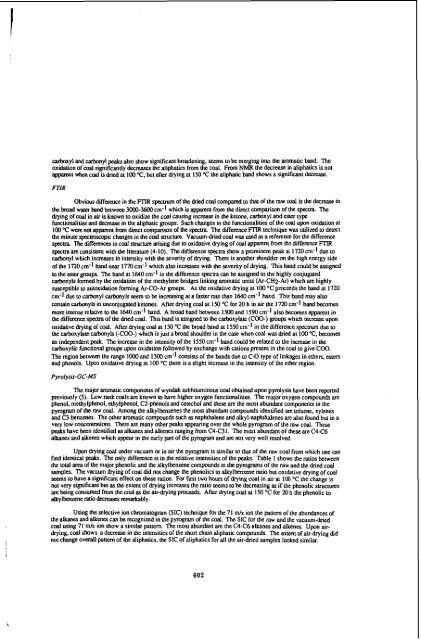liquefaction pathways of bituminous subbituminous coals andtheir
liquefaction pathways of bituminous subbituminous coals andtheir
liquefaction pathways of bituminous subbituminous coals andtheir
Create successful ePaper yourself
Turn your PDF publications into a flip-book with our unique Google optimized e-Paper software.
carbouyl and carbonyl peaks also show significant broadening, seems to be merging into the aromatic band. The<br />
oxidation <strong>of</strong> coal significantly dec- the aliphatics from the coal. From NMR the decrease in aliphatics is not<br />
apparent when coal is dried at 100 T, but after drying at 150 OC the aliphatic band shows a significant decrease.<br />
FTIR<br />
Obvious diffme in the FIlR specwm <strong>of</strong> the dried caal compared to that <strong>of</strong> the raw coal is Ik decrease in<br />
the had water band between 3000-3600 cm-I which IS apparcnt from the direct comparison <strong>of</strong> the specua. The<br />
dyne <strong>of</strong> coal in air is known to oxidize the coal causing increase in the ketone. carboxyl and ester type<br />
functionalities and durease in the aliphatic groups. Such changes in the functionalities <strong>of</strong> the coal upon oxidation at<br />
100 T weat no( apparent from direct Comparison <strong>of</strong> the spectra. The difference FIIR technique was utilized to detect<br />
the minute specmscopic changes in the coal srmcture. Vacuumdried coal was used as a reference for the difference<br />
spccua. ThC differences in coal srmcwre arising due to oxidative drying <strong>of</strong> mal apparent from the difference FllR<br />
spectra are consislent with the licerawre (4-10). Thc difference spectra show a prominent peak a1 1720~m'~ due to<br />
carbonyl which increases in intensity with the severity <strong>of</strong> drying. There is another shoulder on the high energy side<br />
<strong>of</strong> the 1720cm-1 band near 1770 crn-l which also increases with the severity <strong>of</strong> drymg. This band could be assigned<br />
to he ester groups The band at 1640 cm-1 in the difference specba can be assigned to the highly conjugaled<br />
carbonyls formed by the Oxidation <strong>of</strong> the methylene bridges linking aromatic units (Ar-CHz-Ar) which are highly<br />
susceptible to autoxidation forming Ar-CO-Ar groups. As the oxidative drying at 100 "C pmceeds the band at 1720<br />
cm-1 due to uuboxyl carbonyls Seem to be increasing st a faster rak than 1640 cm'l band. This band may also<br />
conlain carbonyls in unconjugaled ketones. After drying coal a1 150 "C for 20 h in afr the 1720 cm-l band becomes<br />
more intense relative lo he 1640 cm-l band. A broad band between I500 and IS90 cm-l also becomes apparent in<br />
the difference spectra <strong>of</strong> the dried coal. This band is assigned to Ihe carboxylate (COO-) pups which incrcasc upon<br />
oxidative drying <strong>of</strong> coal. After drying coal at 150 "C the broad band a1 I550 cm-' in the difference spectrum due to<br />
the carboxylate carbonyls (-COO.) which is just a broad shoulder in the ca~e when coal Wac dned at 100 "C, becomes<br />
an independent peak. The increw in the intensity <strong>of</strong> he 1550 cm-l band could be relaled to the increase in the<br />
carboxylic functional groups upon ox,dation followed by exchange with cationspresent in the coal togive COO.<br />
The region betwcen the range IOOOand 1300 cm.l consists <strong>of</strong> the bands due to C-0 iype <strong>of</strong> linkages in ethers. esters<br />
and phenols. Upon oxidauve drying at 100 'C there is a slight increase in the intensity <strong>of</strong> the cthcr region.<br />
Pyroly sis-GC-MS<br />
The major aromatic components <strong>of</strong> wyodak sub<strong>bituminous</strong> coal obtained upon pyrolysis have been reponed<br />
previously (3). Low rank <strong>coals</strong> are known (0 have higher oxygen functionalities. The major oxygen compounds are<br />
phenol, methylphenol. ethylphenol. C2-phenols and catechol and these are the most abundant components in the<br />
pyrogram <strong>of</strong> the raw coal. Among the alkylbenzenes the most abundant compounds identified are toluene, xylenes<br />
and C3-benzenes. The other aromatic compounds such as naphthalene and alkyl-naphthalenes are also found but in a<br />
very low concentrations. There are many other peaks appearing over the whole pyrogram <strong>of</strong> the raw coal. These<br />
peaks have been identified as alkanes and alkenes ranging from C4C3 1. The most abundant <strong>of</strong> lhese are C4C6<br />
alkanes and alkenes which appear in the early pan <strong>of</strong> the pyrogram and are not very well resolved.<br />
Upon drying coal under vacuum or in air the pyrogram is similar to that <strong>of</strong> the raw coal from which one can<br />
fmd identical peaks. The only difference is in the relative intensities <strong>of</strong> the peaks. Table 1 shows the ratios between<br />
the total am <strong>of</strong> the major phenolic and the alkylbenzene compounds in the pyrograms <strong>of</strong> the raw and the dried coal<br />
samples. The vfcuum drying <strong>of</strong> coal did not change the phenolics to alkylbenme ratio but oxidative drying <strong>of</strong> coal<br />
seems to have a significant effect on these ratios. For fust two hours <strong>of</strong> drying coal in air at 100 OC the change is<br />
not very significanl but as the exlent <strong>of</strong> drying increases the ratio seems to be decreasing as if the phenolic structures<br />
are being consumed fmm he coal as the air-drying pmceeds. After drying coal at 150 "C for 20 h the phenolic lo<br />
alkylbenzene ratio dsreascs remarkably.<br />
Using the selective ion chromatogram (SIC) technique for the 71 mlz ion the paucrn <strong>of</strong> the abundances <strong>of</strong><br />
the alkanes and alkenes can be recognized in the ppgram <strong>of</strong> the coal. The SIC for the raw and the vacuum-dried<br />
coal using 71 mh ion show a similar pattern. The most abundant are the C4-C6 alkanes and alkenes. Upon airdrying.<br />
coal shows a decrease in the intensities <strong>of</strong> the short chain aliphatic compounds. The extent <strong>of</strong> air-drying did<br />
not change overall pa& <strong>of</strong> the aliphatics, the SIC <strong>of</strong> aliphatics for all the air-dried samples looked similar.<br />
602

















